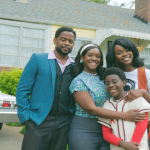Strong Black Woman: How the Media Misses the Intersectionality Story
Cultural
Even people who don’t follow the Olympics remember when gymnast Simone Biles withdrew from several events at the Tokyo Olympics in 2020 citing mental health concerns. Soon, Biles’ face — jubilant, defiant, sad — was on the front page of news outlets around the world.
Whipsawed media coverage portrayed her as a quitter or a champion. Biles brought an important issue to the surface — the hidden battle for Black women’s mental health. And rarely does the media pay attention to concerns of a marginalized population as it did then. Biles’ narrative caught their attention.
Tragically, six months later, 30-year-old Cheslie Kryst, a former Miss USA, committed suicide by leaping from a Manhattan apartment building. Afterwards, the news coverage focused on her achievements as a civil lawyer and pageant participant but tamped down discussion about Black women’s mental health.
University of Florida College of Journalism and Communications Journalism Assistant Professor Rachel Grant and colleagues examined how the media narratives around these two women reflect deeper systemic issues.
Using intersectionality — a framework that explores how multiple oppressive systems affect identity — Grant argues that the media does a disservice to Black women by upholding the stereotype of the Strong Black Woman.
This approach, she says, undermines Black women’s mental health by emphasizing individual resilience while ignoring collective systemic struggles.
“For Black women, the idea of enhanced ‘visibility’ often masks deeper problems,” Grant explains. Her research reveals how media portrayals of both Biles and Kryst presented a one-dimensional understanding of Black womanhood that does not allow them to express or admit vulnerability.
The mythology of the Strong Black Woman, Grant says, originated during slavery as a survival response to violence and oppression. “Today, Black women in the United States no longer have to contend with chattel slavery,” writes Grant, “but they do have to contend with such stressors as racialized sexism and gendered racism.”
Case in point: Simone Biles vs. Michael Phelps. While Biles was vilified for being a “quitter,” the media heaped praise the white male Phelps for opening up about mental health issues.
Grant’s research points to the urgent need for media to develop more nuanced approaches to covering Black women’s experiences, which is where the critical framework of intersectionality can provide a fuller picture of the many identities within one person.
“Using an intersectional discourse analysis allows us to focus on lived experiences to illuminate how power influences mental health,” says Grant.
More importantly, the media can amplify and elevate the work of Black feminist scholars who are using intersectionality to redefine what strength means for the Strong Black Woman.
Intersectionality must be a practice as much as a theory.
The original article, “The Versatility of Intersectionality in Journalism and Mass Communication Research,” was published as an Invited Forum in Journalism & Mass Communication Quarterly in 2023. Rachel Grant’s contribution was part of a scholarly discussion featuring multiple perspectives on intersectionality in journalism research.
Authors: Carolyn Byerly and Bey-Ling Sha (Forum Editors), with contributions from Rachel Grant, George Daniels, Mikayla Pevac and Carolyn Nielsen.
This summary was written by Gigi Marino.
Hero image by Fernando Frazão/Agência Brasil, CC BY 3.0 BR <https://creativecommons.org/licenses/by/3.0/br/deed.en>, via Wikimedia Commons
Posted: November 21, 2024
Insights Categories:
Cultural
Tagged as: Black women, Intersectionality, Rachel Grant


